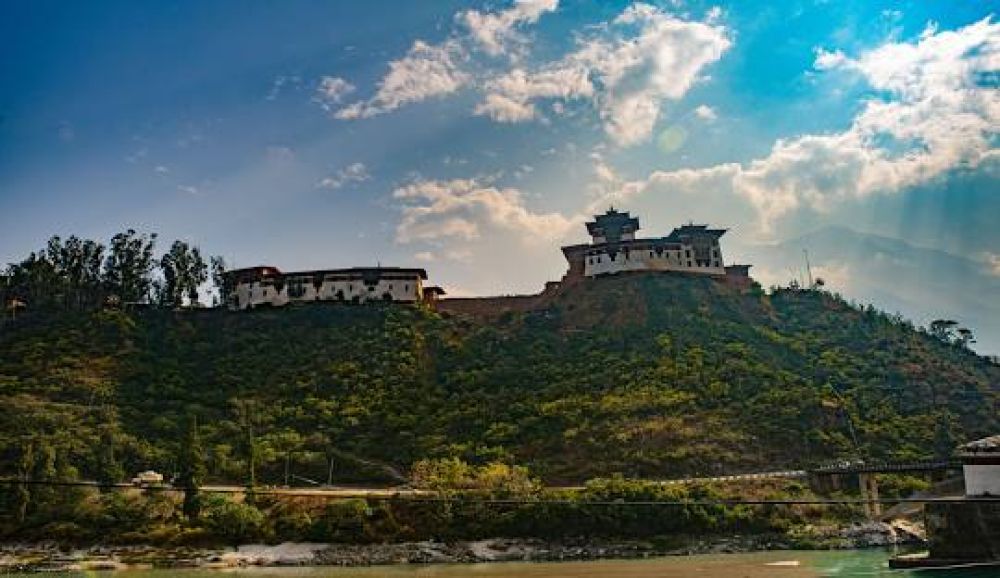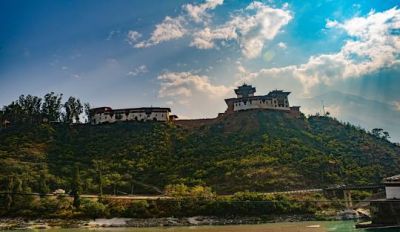

Wangdue Phodrang Dzong is a significant historical and cultural landmark in Bhutan, which dates back to the 17th century. Situated on a hill overlooking the convergence of the Punakha Chhu and Tang Chhu rivers, this majestic fortress served as an administrative and monastic center for the region. Though it was damaged by a fire in 2012, restoration efforts are ongoing to return the Dzong to its original splendor. Inside, visitors can admire the intricate woodwork and beautiful wall paintings that depict Buddhist teachings and mythology. Touring the Dzong offers a glimpse into Bhutan's rich heritage and the Bhutanese architectural genius. A visit typically includes a guided tour that explains the history and cultural significance of the fortress, as well as its structural design and current restoration efforts. It's a must-see for anyone interested in Bhutan's past and its preservation efforts.
Phobjikha Valley, also known as Gangtey Valley, is a stunning natural wonder in Wangdue Phodrang. This U-shaped glacial valley is known for its vast expanse of green meadows and is a significant conservation area for the endangered Black-necked Cranes. From November to early March, these cranes migrate here from Tibet, making the valley a prime location for bird watching. A hike through Phobjikha Valley offers not just the chance to spot these majestic birds but also immerses you in tranquil natural surroundings, characterized by rolling hills and the distant rugged Himalayan landscape. Visitors can embark on nature walks along designated trails, which also encompass the Gangtey Monastery, adding a spiritual element to the journey. Additionally, community-based tourism initiatives provide opportunities to learn about local livelihoods and conservation efforts, creating a holistic and sustainable travel experience.
Just across the Punakha river sits the Rinchengang Village, one of the oldest and most picturesque villages in Bhutan. Notable for its uniformity and traditional stone masonry, the village gives visitors a glimpse of the Bhutanese way of life. Walking through its narrow alleys, lined with old stone houses, one can admire the craftsmanship and the way the community has preserved its traditional architecture. The Rinchengang community is known for their skilled craftsmen and stonework, with many villagers still engaged in this traditional occupation. A visit to Rinchengang allows for engaging interactions with locals and learning about their everyday life, culture, and crafts. This immersive experience often includes the opportunity to taste local cuisine, and on special occasions, witness traditional dances and rituals. It’s a quiet but profound way to connect with the cultural heritage of Wangdue Phodrang.
The Wangdue Phodrang Tshechu is one of the most vibrant and significant festivals in Bhutan. Held annually in the courtyard of the Wangdue Phodrang Dzong, this religious festival is dedicated to Guru Rinpoche, the saint who introduced Buddhism to Bhutan. This colorful event takes place over three days and attracts people from surrounding villages and districts. The festival features a series of mask dances, traditional music, and performances that are both entertaining and spiritually edifying. The costumes and masks add a layer of mystical beauty to the event, highlighting various Buddhist deities and historical figures. The climactic moment of the Tshechu is the unfurling of the Guru Tshengye Thongdrol, a large tapestry that is said to cleanse onlookers of their sins upon sight. For visitors, this is a unique opportunity to experience Bhutanese culture, spirituality, and communal harmony in one of the most authentic settings possible.
The Black-necked Crane Festival is an annual event celebrated in the Phobjikha Valley to honor the arrival of the Black-necked Cranes. This festival usually takes place in November and is hosted by the local community and the Royal Society for the Protection of Nature (RSPN) to generate awareness and support for crane conservation. The festival is marked by folk songs, dances, crane-themed games, and masked performances that are deeply symbolic in Bhutanese culture. It's a lively and joyous occasion that brings together conservationists, locals, and tourists to celebrate the significance of these rare and beautiful birds. Attendees of the festival also contribute to the local economy and eco-friendly tourism, fostering a better understanding between humans and the natural world. The festival typically concludes with the cranes gracing the skies above the valley – a magical sight for nature lovers.
For adventure enthusiasts visiting Wangdue Phodrang, a rafting trip down the Punakha River is a must-try activity. Offering both gentle and adrenaline-pumping stretches of white water, the Punakha River provides an exhilarating way to experience Bhutan's landscape. Along the ride, rafters can enjoy the breathtaking scenery of terraced rice fields, traditional farmhouses, and the grandeur of the Punakha Dzong. Rafting tours are operated by experienced guides who ensure safety while providing a fun-filled experience. Rafting trips can be tailored to suit different levels of expertise, from family-friendly floats to more challenging rapids for experienced thrill-seekers. This activity is a unique blend of adventure, cultural immersion, and scenic beauty. It is a chance to witness Bhutan's natural wonders from a fresh perspective while enjoying the thrill of the rapids.
Khotokha Valley is a hidden gem in Wangdue Phodrang, known for its serene landscapes and rich biodiversity. The valley is a paradise for trekkers and birdwatchers, offering a tranquil escape from the bustle of popular tourist sites. The trek to Khotokha involves walking through lush forests, crossing high-altitude passes, and discovering remote mountainous areas that are home to traditional Bhutanese villages. Along the path, trekkers can spot a variety of bird species, and with some luck, even glimpse rare animals native to the area. The trek can be challenging, but the rewards are great: panoramic views, peaceful nature, and encounters with warm-hearted locals. A typical trek to Khotokha might include a guided tour with stops at points of interest, making it an enriching journey into the soul of Bhutan's wilderness.
Perched on a hilltop in the Phobjikha Valley, the Gangtey Monastery or Gangtey Goenpa is an important religious site for Bhutanese Buddhism and a must-visit cultural destination in Wangdue Phodrang. This 16th-century monastery is home to the Peling lineage of monks and is an architectural marvel, with a stunning view of the valley below. A cultural tour of Gangtey Monastery often includes a guided walk through the complex, learning about its history, spiritual practices, and cultural significance. Visitors are treated to a tranquil atmosphere and can sometimes interact with the monks, witnessing their daily rituals and lives. The surrounding village has several homestays and guest houses, allowing visitors to extend their stay and enjoy local hospitality. This cultural tour is not just about sightseeing but also about absorbing the monastery's teachings, meditative environment, and its role in local community life.
Cycling enthusiasts will find the Punakha Valley in Wangdue Phodrang a perfect place to explore on two wheels. The valley's relatively flat terrains, combined with its delightful climate, make for an enjoyable and scenic biking experience. Riders can pedal through paddy fields, alongside the river banks, and through quaint villages, taking in the peace and beauty of rural Bhutan. Bike rentals and guided tours are available and cater to various skill levels, ensuring that everyone from novices to seasoned cyclists can appreciate the ride. Stops often include local landmarks, such as the Punakha Dzong and suspension bridges, allowing bikers to combine physical activity with cultural sightseeing. The freedom of biking through such an idyllic landscape is a perfect way to connect with nature and see the countryside at a leisurely pace.
For a truly immersive experience in Bhutanese culture and hospitality, consider a homestay in one of the traditional villages in Wangdue Phodrang. This unique opportunity allows travelers to live with a local family, share meals, and learn about their day-to-day life. The warmth and simplicity of village life can be deeply moving, giving visitors a chance to connect beyond the usual tourist attractions. From helping with farm work to learning how to cook authentic Bhutanese dishes, a homestay is a real cultural exchange. This experience is also a meaningful way to support the local economy and sustainable tourism practices. While staying in a village, guests often participate in various cultural activities, such as traditional archery, textile weaving, or attending local festivals. It is an enriching way to see Bhutan from the inside and make lasting connections with its people.
